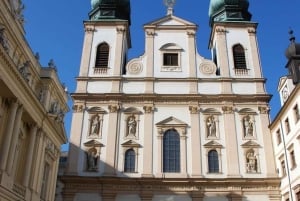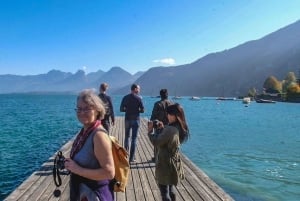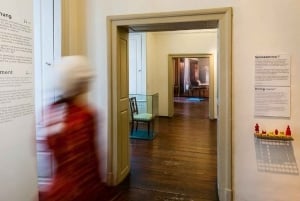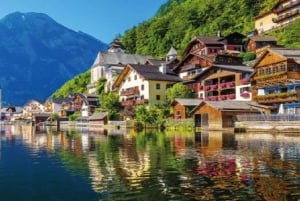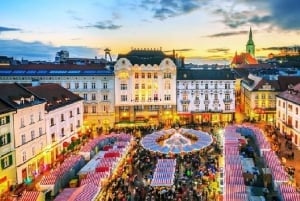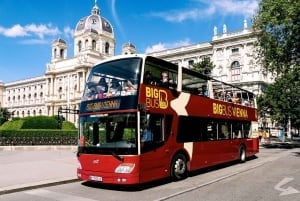Other Important Sights
Vienna's historical sights are truly amazing - there are so many of them that it is a real challenge to pick the right ones for you. Our MyDestination team has come up with a dedicated section called TOP ATTRACTIONS including all the sights you have to see and should not miss! Check out these most important places.
However there is so much more to see! Here below we are mentioning additional important highlights. The best part is that all of Vienna's sights can easily be visited and explored walking, by bike or on public transport. So take your pick ...
The Jewish Square - Judenplatz
This is another very worthy highlight in Vienna to go and see!
People might have a somewhat complex relationship to the European Holocaust and Austrias role during WW II; it is especially challenging to discuss Austrias role and responsibility for the terrible crimes committed to mankind during this time. However, the city of Vienna has been doing its best in the past decades to ensure that Jewish heritage is well represented in the capital, and has been dedicating many resources and efforts to ensure that this very important part of Vienna's past is not forgotten. The "Judenplatz" ranks highly amongst the most attractive of Vienna's many public squares and it also marks the area of the Viennese Jewish ghetto, which was based here around 700 years ago.
Today the square is where a lot of Jewish-themed attractions are found: the most well known of them is the modern Holocaust Memorial (Holocaust Mahnmal), but also, and not less important - the Jewish cultural centre as well as the Museum Judenplatz. In the latter you can see artefacts and get information about the prominent medieval synagogue which once stood in this very spot. It is a very interesting chapter of Austria's past to discover - check it out, you will not be disappointed!
The Church am Steinhof - Kirche am Steinhof
This magnificent church is located on top of a hill at the city outskirts - it will take you half an hour to get there from the city centre. One of Vienna's art nouveau masterpieces was built here by Austria's most famous architect Otto Wagner in the beginning of the 19th century. The church was built on the grounds of Vienna’s "Steinhof Psychiatric Hospital" - intended for the patients use. This resulted in a church interior entirely clad in tiles - to ensure easy cleaning! All pews in the church were given rounded edges to minimize injuries and even the holy water is dispensed by a drip opposite the traditional stoup, to prevent infection! It is really quite remarkable. Since contemporary hospital wards were segregated by sex, separate entries were provided for men and women. Also, check out the numerous emergency exits, lavatories and on-premise examination rooms - other distinct features of this institutional church. Quite an impressive site...but, never mind the patient focus - you should definitely not miss the beautiful stained glass windows and copious mosaics by our Austrian artist Koloman Moser, one of the founders of the Vienna Secession and its Art nouveau Movement.
The Church of St. Peters - Peterskirche
This impressive church is located right in the city center and occupies most of a very small square. It is actually exaggerated to call it a square as the surrounding buildings are so overwhelming and prominent. The Peterskirche was built in the eight century, but it is thought that the original foundations date back to Roman times. The interesting part is definitely the interior, it is really quite peculiar. The church has a monumental dome which is completely overshadowed by two huge towers - how come? Well, it is thought that the tiny square was the main reason this church was designed in this odd way - it had to appear to be grand, but the space was limited! The mainly baroque interior is so sumptuously decorated and overwhelming! You will see many marble pilasters, gilded sculptures, intricate stucco and impressive frescoes - all of it is a really lavish work of art! Go and have a look - it is well worth it!
Zentralfriedhof - Vienna's central cemetery
This might seem to be quite a morbid recommendation to make, but trust us, it will be an unforgettable and really interesting visit! The Zentralfriedhof is by far Vienna's biggest cemetery and even the second largest in Europe and it is a magnificent attraction for locals (yes, Viennese like visiting their dead loved ones) as well as for visitors! The cemetery was built in late 19th century and is situated close to todays city center (originally it was located outside city walls). Today approximately 330,000 graves are located here and over the last century approximately 3 million people have been buried here! This is really huge and quite unique place since every tomb is a piece of art in itself. For art nouveau lovers: the cemetery hosts one of the most spectacular Jugendstil churches in Vienna called the Barromäus Kirche.
One of the singularities of the Zentralfriedhof, not quite to be found elsewhere, is its interdenominational character, meaning that the cemetery is open to most religious denominations. Yes, you can visit sections such as the (by far largest) Catholic section, as well as the Orthodox, or the Protestant, or the Jewish section - even a Muslim or Buddhist section is to be found here! But not only that, some of the most famous Austrians are buried here and one tombstone outshines the other! Viennese like to spend money on elaborating and lavishing graves ... go and have a look! Some examples to visit: composers like Brahms, Schubert, Beethoven, Strauss, etc. but also politicians, writers and architects.
St. Marx cemetery - St. Marxer Friedhof
Yes, another cemetery well worth visiting ... as we mentioned, Viennese like to take care of their deceased loved ones. It was opened in 1874 and has become famous because it is the original resting place of Wolfgang Amadeus Mozart. It was written that Mozart was given a pauper's funeral by putting his body in one of the unnamed mass graves. Later on, a big space called "Mozartgrab" was allocated in order to commemorate him. You can easily recognise it through its broken pillar and a mourning angel showing his untimely death - quite dramatic! But it is not only Mozart who makes this place special ... the rows and rows of old, old gravestones, halfway covered by overgrowing trees and bushes ... it feels like taking a hike through a forest and discovering a secret graveyard, an adventure in a way! In springtime the place gets an extra surreal when nature awakens and peacocks wander within the grave lines. Definitely a highlight if you are here in that season!


